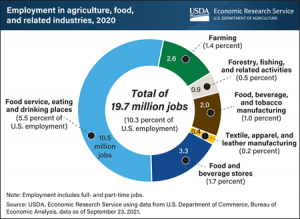The agriculture industry provides us much more than three meals a day — it is an economic driver in addition to giving us the fuel and fiber to power our day. We know the statistic that farm and ranch families comprise less than 2 percent of the U.S. population. However, the agriculture industry encompasses more than the farmers and ranchers who grow our food. According to USDA’s Economic Research Service, agriculture, food, and related industries provide jobs for 10.3 percent of the American population.
The ERS recorded 19.7 million full- and part-time jobs were related to the agricultural and food sectors, 10.3 percent of total U.S. employment in 2020. Direct on-farm employment accounted for about 2.6 million of these jobs, or 1.4 percent of U.S. employment. Employment in agriculture- and food-related industries supported another 17.1 million jobs. Of this, food service, eating and drinking places accounted for the largest share at 10.5 million jobs. Food and beverage stores supported 3.3 million jobs. The remaining agriculture-related industries together added another 3.3 million jobs.

This chart appears in the collection Ag and Food Statistics: Charting the Essentials on the ERS website.
For the agriculture industry, this is exciting news when compared to 2012 data. In 2012, only 16.5 million full- and part-time jobs were related to agriculture — 9.2 percent of total U.S. employment. That means 3.2 million jobs have been added to the agriculture sector in nine years. The proves that the industry is full of opportunities for future agriculture students and workers.
According to the ERS website in 2012, direct on-farm employment provided over 2.6 million of these jobs. Employment in the related industries supported another 13.9 million jobs. Of this number, food services and drinking places accounted for the largest share—10.8 million jobs—and food manufacturing supported 1.5 million jobs. The remaining agriculture-related industries together supported another 1.5 million jobs.
With over 10 percent of jobs attributed to agriculture, the industry also has a major impact on the U.S. economy. Agriculture, food, and related industries contributed $1.109 trillion to the U.S. gross domestic product (GDP) in 2019, a 5.2-percent share. According to the ERS, the output of America’s farms contributed $136.1 billion of this sum — about 0.6 percent of GDP. The overall contribution of agriculture to GDP is actually larger than 0.6 percent because sectors related to agriculture rely on agricultural inputs in order to contribute added value to the economy. Sectors related to agriculture include: food and beverage manufacturing; food and beverage stores; food services and eating and drinking places; textiles, apparel, and leather products; and forestry and fishing.


